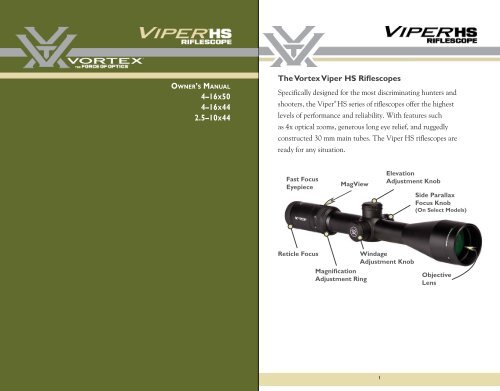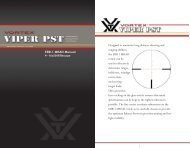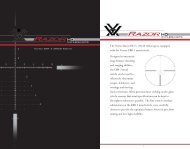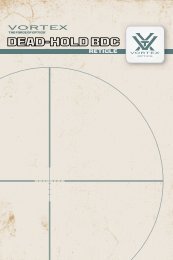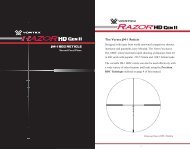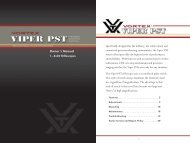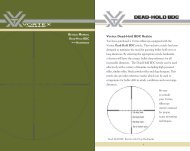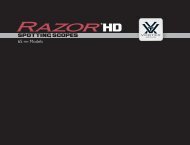vortex viper hs rifle scope manual - EuroOptic.com
vortex viper hs rifle scope manual - EuroOptic.com
vortex viper hs rifle scope manual - EuroOptic.com
You also want an ePaper? Increase the reach of your titles
YUMPU automatically turns print PDFs into web optimized ePapers that Google loves.
OWNER’S MANUAL4–16X504–16X442.5–10X44The Vortex Viper HS Rifle<strong>scope</strong>sSpecifically designed for the most discriminating hunters andshooters, the Viper ® HS series of <strong>rifle</strong><strong>scope</strong>s offer the highestlevels of performance and reliability. With features suchas 4x optical zooms, generous long eye relief, and ruggedlyconstructed 30 mm main tubes. The Viper HS <strong>rifle</strong><strong>scope</strong>s areready for any situation.Fast FocusEyepieceMagViewElevationAdjustment KnobSide ParallaxFocus Knob(On Select Models)Reticle FocusWindageAdjustment KnobMagnificationAdjustment RingObjectiveLens1
RIFLESCOPE ADJUSTMENTSReticle FocusVortex Viper HS <strong>rifle</strong><strong>scope</strong>s use a fast focus eyepiece designed toquickly and easily adjust the focus on the <strong>rifle</strong><strong>scope</strong>’s reticle.To adjust the reticle focus:• Look through the <strong>rifle</strong><strong>scope</strong>at a blank white wall or up atthe sky.• Turn the eyepiece focusknob in or out until the reticleimage is as crisp as possible.• Note: Try to make thisAdjust the reticle focusparticular adjustment quickly,as the eye will try to <strong>com</strong>pensate for an out-of-focus reticle.Once this adjustment is <strong>com</strong>plete, it will not be necessary tore-focus every time you use the <strong>rifle</strong><strong>scope</strong>. However, becauseyour eyesight may change over time, you should re-check thisadjustment periodically.WarningLooking directly at the sun through a <strong>rifle</strong><strong>scope</strong>, or any opticalinstrument, can cause severe and permanent damage to youreyesight.Windage and Elevation AdjustmentsThe Viper HS <strong>rifle</strong><strong>scope</strong> incorporates adjustable elevation andwindage dials with audible clicks. Each audible click moves thebullet’s point-of-impact 1/4 of a minute of angle (MOA).1/4 MOA closely corresponds to 1/4 inch at 100 yards, 1/2 inchat 200 yards, 3/4 inch at 300 yards...taking four (4) clicks tomove the bullet’s point-of-impact approximately one inch at100 yards.How to adjust windage and elevation settingsBegin adjusting the windage and elevation settings by firstremoving the outer covers. Then,move the turrets in the directionyou wish the bullet’s point-ofimpactto change. To make theadjustments, dial the adjustmentknob in the appropriate direction(up/down or left/right) asindicated by the arrows.To adjust settings, turn knobs· Up / DownAfter sight-in, you can realignthe zero marks on the· Left / Rightturret knobs with the reference dots if you wish (see ResettingAdjustment Dials with Zero Reset section). Replace outer coverswhen done.23
Side Focus Parallax AdjustmentViper HS 4–16x44 and 4–16x50 <strong>rifle</strong><strong>scope</strong>s use a side focusparallax adjustment which provides maximum image sharpnessand eliminates parallax error. The Viper HS 2.5–10x44<strong>rifle</strong><strong>scope</strong>s do not use side focus parallax adjustments and arepre-focused at a distance of 100 yards.Side Parallax Focus Knob on4–16x44 and 4–16x50Parallax is a phenomenon that results when the targetimage does not quite fall on the same optical plane asthe reticle within the <strong>scope</strong>. When the shooter’s eyeis not precisely centered in the eyepiece, there can beapparent movement of the target in relation to thereticle, which can cause a small shift in the point ofaim. Parallax error is most problematic for precisionshooters using high magnification.Setting the side focus:• Be sure the reticle is correctly focused (see Reticle Focus).• As accurately as possible, match the yardage number(distance you are shooting) onside focus parallax adjustmentknob to the indicator arrow onthe <strong>scope</strong> body.• Check the setting foraccuracy by looking throughthe <strong>scope</strong> to verify imagesharpness and, at the sametime, look for reticle shift while Adjust the side parallax knobmoving your head back andforth. The setting is correct if there is no apparent movementbetween the reticle and target while your head is moving backand forth. If there is apparent movement, adjust the focus knobslightly until the movement is eliminated.When properly set, the target image should be sharp and crisp.45
Variable Power AdjustmentsTo change magnifications,turn the magnification ringto the desired level. TheVortex MagView fiber opticmagnification indicator willprovide a low light reference formagnification level.Magnification and Reticle SubtensionThe reticle subtensions listed on <strong>vortex</strong>optics.<strong>com</strong> or in thereticle <strong>manual</strong> are only valid at the highest magnification ofthe <strong>rifle</strong><strong>scope</strong>. However, by understanding the relationshipof magnification and subtensions, the shooter can stilleasily calculate ranging, holdovers and wind drift at partialmagnifications (2x, 3x and 4x markings). Some HS models use aSubtension Multiplier Scale.• If magnification is set to full power (1x on dial),subtension values will be the spec listed.• If magnification is set at half of the full power (2x on dial),subtension values will be two times the spec listed.• If magnification is set at a third of the full power (3x ondial), subtension values will be three times the spec listed.• If magnification (4x on dial) is set at a quarter of the fullpower, subtension values will be four times the spec listed.6SubtensionMultiplierScaleMagnificationScaleMagViewIndicatorRIFLESCOPE MOUNTINGTo get the best performance from your Vortex Viper HS <strong>rifle</strong><strong>scope</strong>,proper mounting is essential. Although notdifficult, the correct steps must be followed.If you are unsure of your abilities, it wouldbe best to use the services of a qualifiedgunsmith.Rings and BasesMount an appropriate base and matching rings to your <strong>rifle</strong> accordingto the manufacturer’s instructions. The Vortex Viper HS <strong>rifle</strong><strong>scope</strong>srequire 30mm rings.Use the lowest ring height that will provide <strong>com</strong>plete clearance of<strong>scope</strong> and <strong>rifle</strong>—avoiding any contact with barrel, receiver, bolthandle or any other part of the <strong>rifle</strong>. A low mounting will help assureproper cheek weld, aid in establishing a solid shooting position, andpromote fast target acquisition.Centering of the ReticleIf you wish to re-center the reticle to the center, this can be doneeasily:• Turn the windage or elevation dial as far as possible in eitherdirection. Do not force the dial. As soon as any any resistance is felt,stop turning.• Carefully count the dial rotations while turning the dial back inthe opposite direction. Stop turning as soon as resistance is felt.• Turn the dial the other direction to half the amount of rotationscounted in step one.Complete this procedure for both windage and elevation dials toapproximately center the reticle.7
Eye Relief and Reticle AlignmentAfter installing the bottom ring halves on the mounting base,place the <strong>rifle</strong><strong>scope</strong> on the bottom ring halves and loosely installthe upper ring halves. Before tightening the <strong>scope</strong> ring screws,adjust for maximum eye relief to avoid injury from recoil:• Set the <strong>rifle</strong><strong>scope</strong> to the middle of its magnification range.• Slide the <strong>rifle</strong><strong>scope</strong> as far forward as possible in the rings.• While viewing through the <strong>rifle</strong><strong>scope</strong> in a normal shootingposition, slowly slide the <strong>rifle</strong><strong>scope</strong> back towards the shooter’sface—paying attention to the field of view. Just as the full viewis visible, stop.• Without disturbing the front-back placement, rotate the<strong>rifle</strong><strong>scope</strong> until the vertical crosshair exactly matches thevertical axis of the <strong>rifle</strong>. Use of a reticle leveling tool, a weighthung on a rope, or an adjustable set of feeler gauges will helpwith this procedure.Bore SightingInitial bore sighting of the <strong>rifle</strong><strong>scope</strong> will save time and moneyat the range. This can be done by using a mechanical or laserbore sighter according to the manufacturer’s instructions or byremoving the bolt and sighting through the barrel on some <strong>rifle</strong>s.To visually bore sight a <strong>rifle</strong>:• Place the <strong>rifle</strong> solidly on a rest and remove the bolt.• Sight through the bore at a target approximately 100 yardsaway.• Move the <strong>rifle</strong> and rest until the target is visually centeredinside the barrel.• With the target centered in the bore, make windage andelevation adjustments until the reticle crosshair is also centeredover the target.• After aligning the reticle, tighten and torque the ringscrews down per the manufacturer’s instructions.Use of an adjustable setof feeler gauges betweena one-piece base and flatbottom section of the<strong>rifle</strong><strong>scope</strong> to square the<strong>rifle</strong><strong>scope</strong> (and reticle) tothe base.Visually bore-sighting a <strong>rifle</strong>.89
Final Range Sight-InAfter the <strong>rifle</strong><strong>scope</strong> has been bore-sighted, final sight-in shouldbe done at the range using the exact ammunition expectedto be used while shooting. Sight in and zero the <strong>rifle</strong><strong>scope</strong> atthe preferred distance. 100 yards is the most <strong>com</strong>mon zerodistance, although a 200 yard zero may be preferred for longrange applications.Be sure the reticle is in focus (see Reticle Focus) and set theparallax adjustment to match the distance being used forsight-in:• Following all safe shooting practices, fire a three-shotgroup as precisely as possible.• Next, adjust the reticle to match the approximate centerof the shot group (see section on Windage and ElevationAdjustment).Resetting Adjustment Dials with Zero ResetViper HS <strong>rifle</strong><strong>scope</strong>s feature windage/elevation dials wthat willallow you to re-index the zero indicator after sight-in withoutdisturbing your settings. This allows you to quickly return toyour original zero if temporary corrections are used in the field.Reset the windage and elevation dials in this way:1. Remove the outer cap and pull the adjustment dial outwardagainst the spring tension until it stops.2. With the dial pulled fully outwards, rotate the dial toreposition the zero mark on the index line.3. Release the dial, allowing it to return to the normal inwardposition.Remove the outer cap andexpose the turret dial.Note: If the <strong>rifle</strong> is very solidly mounted and cannot be moved,simply look through the <strong>scope</strong> and adjust the reticle until it iscentered on the fired group.• Carefully fire another three-shot group and see if thebullet group is centered on the bullseye.This procedure can be repeated as many times as necessary toachieve a perfect zero.Grasp turret dial, pullupward and rotate untilthe etched zero mark(arrow) aligns with theindicator line on <strong>scope</strong>body.1011
MAINTENANCECleaningThe fully waterproof and fogproof Vortex Viper HS <strong>rifle</strong><strong>scope</strong>requires very little routine maintenance other than periodicallycleaning the exterior lenses. The exterior of the <strong>scope</strong> may becleaned by wiping with a soft, dry cloth.When cleaning the lenses, be sure to use products, such asthe Vortex Fog Free cleaning products or Lens Pen, that arespecifically designed for use on coated optical lenses.• Be sure to blow away any dust or grit on the lenses priorto wiping the surfaces.• Using your breath, or a very small amount of water orpure alcohol, can help remove stubborn things like driedwater spots.LubricationAll <strong>com</strong>ponents of the Vortex Viper HS <strong>rifle</strong><strong>scope</strong>s arepermanently lubricated, so no additional lubricant should beapplied.Note: Other than to remove the turret caps, do not attempt todisassemble any <strong>com</strong>ponents of the <strong>rifle</strong><strong>scope</strong>. Disassembling of<strong>rifle</strong><strong>scope</strong> may void warranty.StorageIf possible, avoid exposing your Vortex <strong>rifle</strong><strong>scope</strong> to directsunlight or any very hot location for long periods of time.TROUBLESHOOTINGSighting-in ProblemsMany times, problems thought to be with the <strong>scope</strong> are actuallymount problems. Be sure the mounts are tight to the <strong>rifle</strong> and the<strong>scope</strong> is secured so it doesn’t twist or move in the rings.An insufficient windage or elevation adjustment range may indicateproblems with the base mount, base mount holes drilled in the <strong>rifle</strong>’sreceiver, or barrel/receiver alignment.Check for Correct Base and Ring Alignment• Re-center the <strong>scope</strong> reticle (see Centering of the Reticle).• Attach bore sighter, or remove bolt and visually boresight <strong>rifle</strong>.• Look through the <strong>scope</strong>. If the reticle appears way off center onthe boresighter image or when <strong>com</strong>pared to the visually centeredtarget when looking through <strong>rifle</strong>’s bore, there may be a problemwith the bases or rings being used. Confirm that correct base andrings are being used—and in the proper orientation.Grouping ProblemsThere are many issues that can cause poor bullet grouping.• Maintain a good shooting technique and use a solid rest.• Check that all screws on <strong>rifle</strong>’s action are properly tightened.• Be sure <strong>rifle</strong> barrel and action are clean and free of excessiveoil or copper fouling.• Check that rings are correctly torqued per the manufacturer’sinstructions.• Some <strong>rifle</strong>s and ammunition don’t work well together—trydifferent ammunition and see if accuracy improves.1213
THE VIP WARRANTYWe build optics based on our <strong>com</strong>mitment to your absolute satisfaction.That’s why Vortex products are unconditionally guaranteed.Vortex pledges this Very Important Promise to you—a Very ImportantPerson.Our VIP unlimited, unconditional warrantycovers your Viper HS <strong>rifle</strong><strong>scope</strong> in the eventit requires service. No matter the cause,Vortex Optics will repair or replace thebinocular at no charge to you.Call <strong>vortex</strong> Optics at 800-426-0048 for prompt, professional, andfriendly service.Vortex Optics2120 West Greenview DriveMiddleton, WI 53562service@<strong>vortex</strong>optics.<strong>com</strong>Visit Vortex Optics at <strong>vortex</strong>optics.<strong>com</strong> for more information.© Vortex Optics usa14


